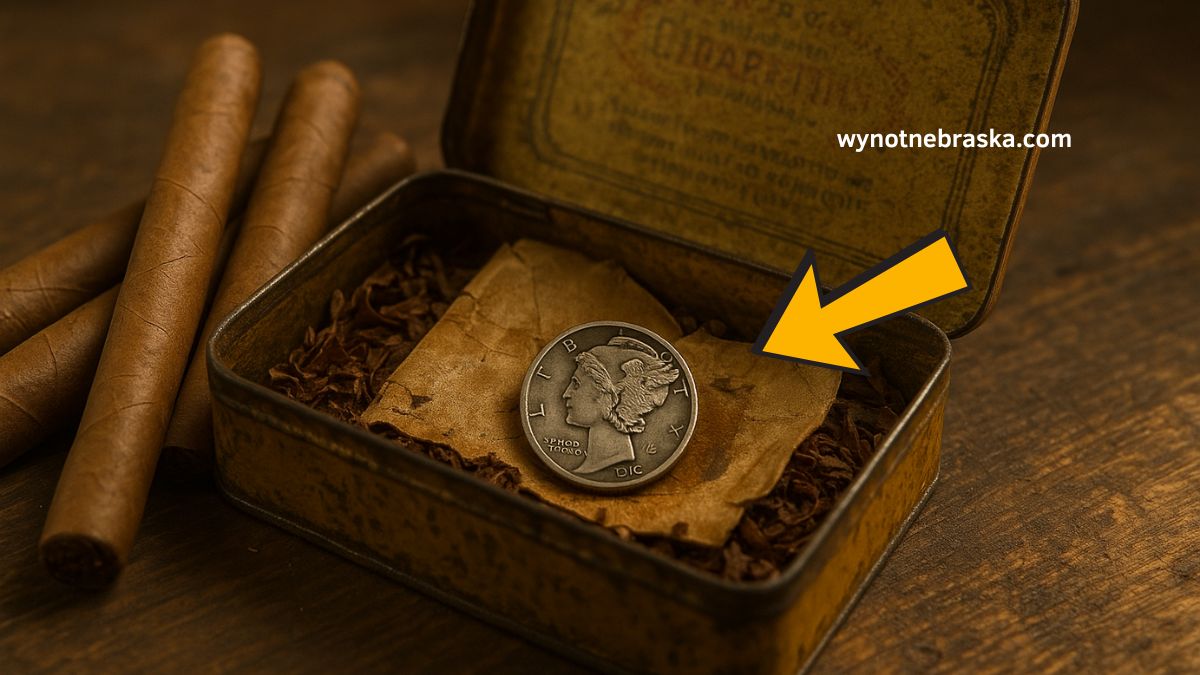In a truly extraordinary find that has stunned the numismatic world, a rare 1916-D Mercury Dime, uncovered inside an old cigar tin, recently sold at auction for a staggering $130,000.
The coin, tucked away for decades in a dusty attic, was part of a forgotten family heirloom that turned out to be a fortune in disguise.
The Incredible Discovery in a Cigar Tin
The story begins with a family in Pennsylvania cleaning out their grandfather’s attic. Among vintage tools, tobacco memorabilia, and other forgotten belongings, they came across a metal cigar tin.
Inside were several old coins, but one in particular stood out — a small silver dime dated 1916 with a small “D” mintmark on the reverse.
Upon having the coin examined by a professional numismatist, it was quickly confirmed to be an authentic 1916-D Mercury Dime, one of the rarest and most sought-after U.S. coins.
Further evaluation revealed it was in remarkable condition, receiving a Mint State 62 Full Bands (MS62 FB) grade, which significantly boosted its market value.
Why the 1916-D Mercury Dime Is So Valuable
The 1916-D Mercury Dime holds legendary status in U.S. coin collecting circles. Several unique attributes contribute to its extraordinary worth:
- Low Mintage: Only 264,000 of these dimes were struck at the Denver Mint, making it the rarest issue in the entire Mercury Dime series.
- Key Date: As the first year of the Mercury Dime series, the 1916 coins already hold historical significance. The “D” mintmark (for Denver) adds extreme rarity.
- Full Bands Rarity: Coins with well-defined, fully separated horizontal bands on the fasces (reverse side) are graded as Full Bands, which are incredibly hard to find and command premium prices.
- Condition Sensitivity: Given the age and the softness of the silver used, very few examples survive in high grades today.
Auction Shocks Collectors with $130,000 Final Bid
The coin, authenticated and graded by a reputable grading service, was placed into an elite numismatic auction in April 2025. Competitive bidding erupted as seasoned collectors recognized its condition and the compelling story behind its discovery.
When the hammer finally fell, the 1916-D Mercury Dime hidden in the cigar tin sold for $130,000, exceeding pre-auction estimates and breaking records for its grade.
Specifications and Historical Significance
Here’s a detailed look at the features of this iconic coin:
| Specification | Detail |
|---|---|
| Year of Issue | 1916 |
| Mint Mark | D (Denver) |
| Total Mintage | 264,000 |
| Series Name | Mercury Dime (Winged Liberty Head) |
| Designer | Adolph A. Weinman |
| Composition | 90% Silver, 10% Copper |
| Diameter | 17.9 mm |
| Weight | 2.5 grams |
| Grade Received | MS62 Full Bands (FB) |
| Auction Sale Price | $130,000 |
| Date of Auction | April 2025 |
| Found Location | Inside a vintage cigar tin in an attic |
Mercury Dime Legacy
The Mercury Dime was minted from 1916 to 1945, designed by famed sculptor Adolph A. Weinman. Although referred to as the “Mercury Dime,” the obverse actually depicts Liberty wearing a winged cap, symbolizing freedom of thought — not the Roman god Mercury.
The Denver Mint only produced a small batch in 1916, contributing to the rarity of the 1916-D version. That limited run, combined with its role as the first coin in the series, gives it iconic status among collectors.
The incredible story of a 1916-D Mercury Dime found in a cigar tin and sold for $130,000 is a reminder of the hidden treasures that may lie forgotten in our homes.
Whether it’s tucked away in a jewelry box, attic chest, or an old tin, history can surprise us at any moment. For coin collectors, this find revives excitement in the pursuit of rare coins and encourages a second look at what might be hiding in plain sight.
FAQs
How can I identify a 1916-D Mercury Dime?
Look at the reverse side near the bottom left — if there’s a small “D” mintmark and the front reads 1916, you may have a 1916-D. Have it authenticated to verify value.
Why is the 1916-D Mercury Dime so rare?
It had a mintage of only 264,000 coins, the lowest of the entire Mercury Dime series. Most were circulated and worn down, making well-preserved examples extremely scarce.
What does Full Bands (FB) mean?
It refers to sharp and complete horizontal lines on the fasces (reverse). Full Bands indicate a strong strike and raise the coin’s value dramatically.

